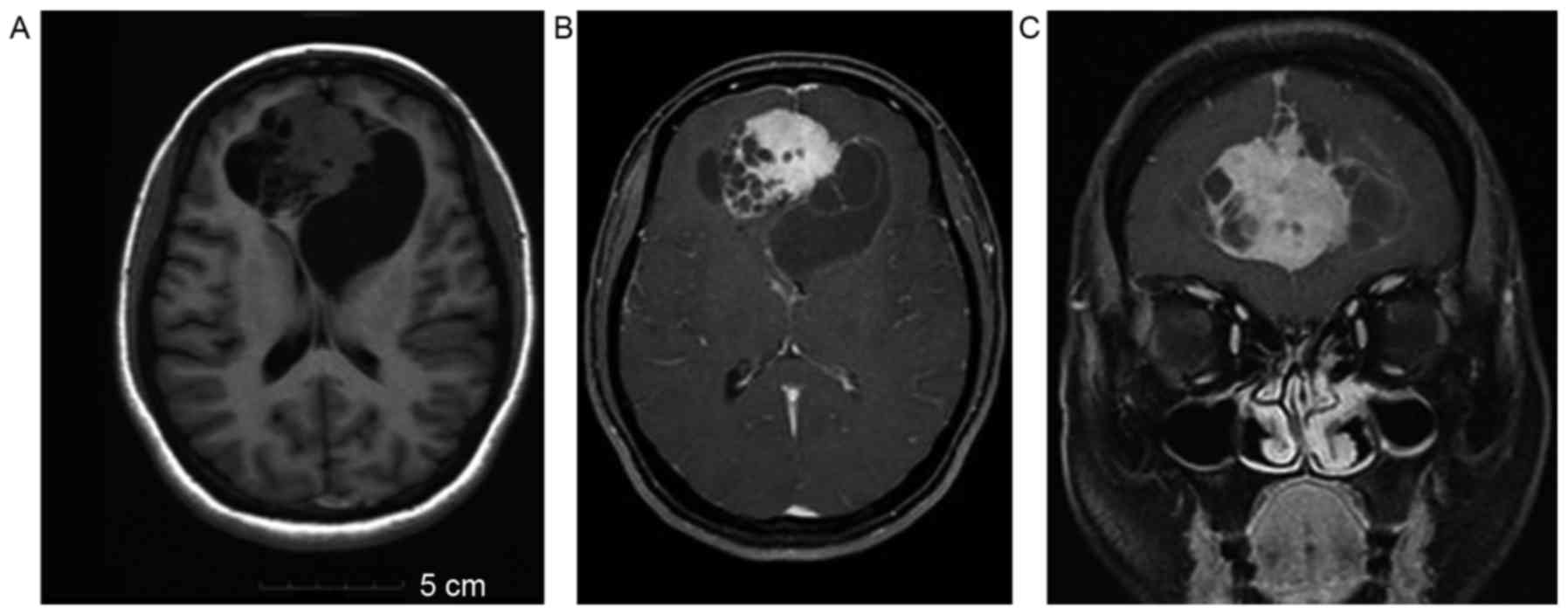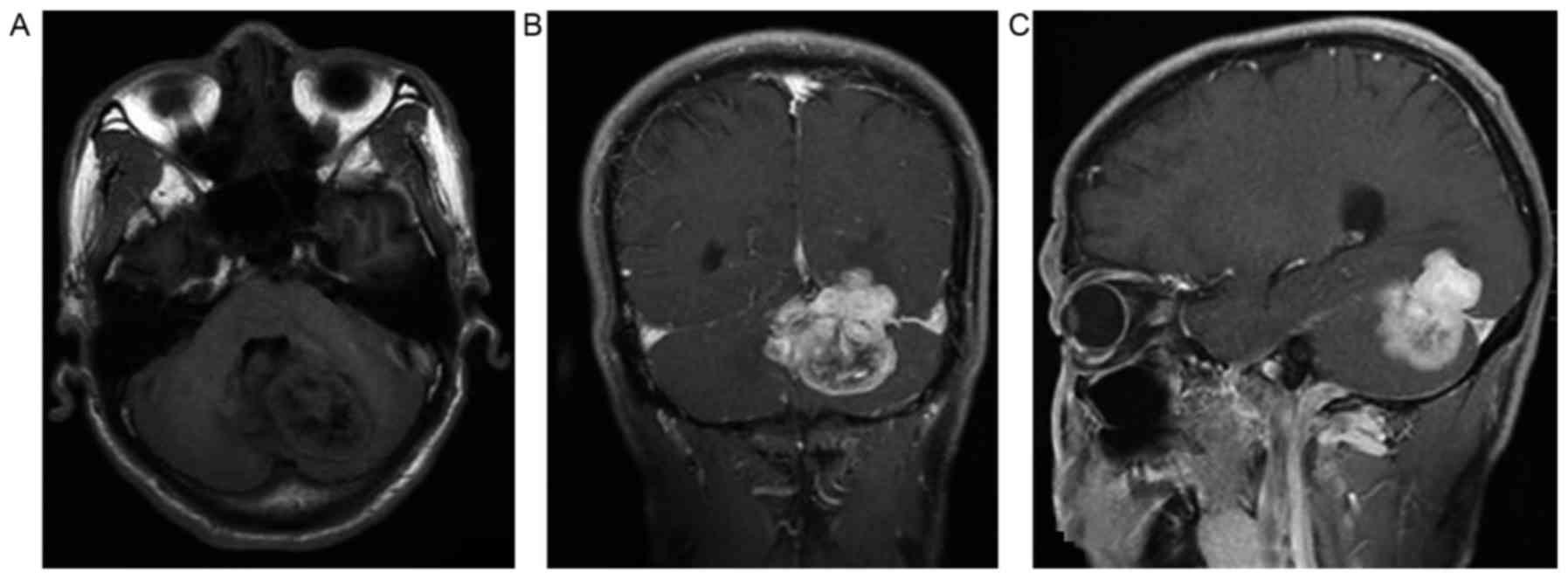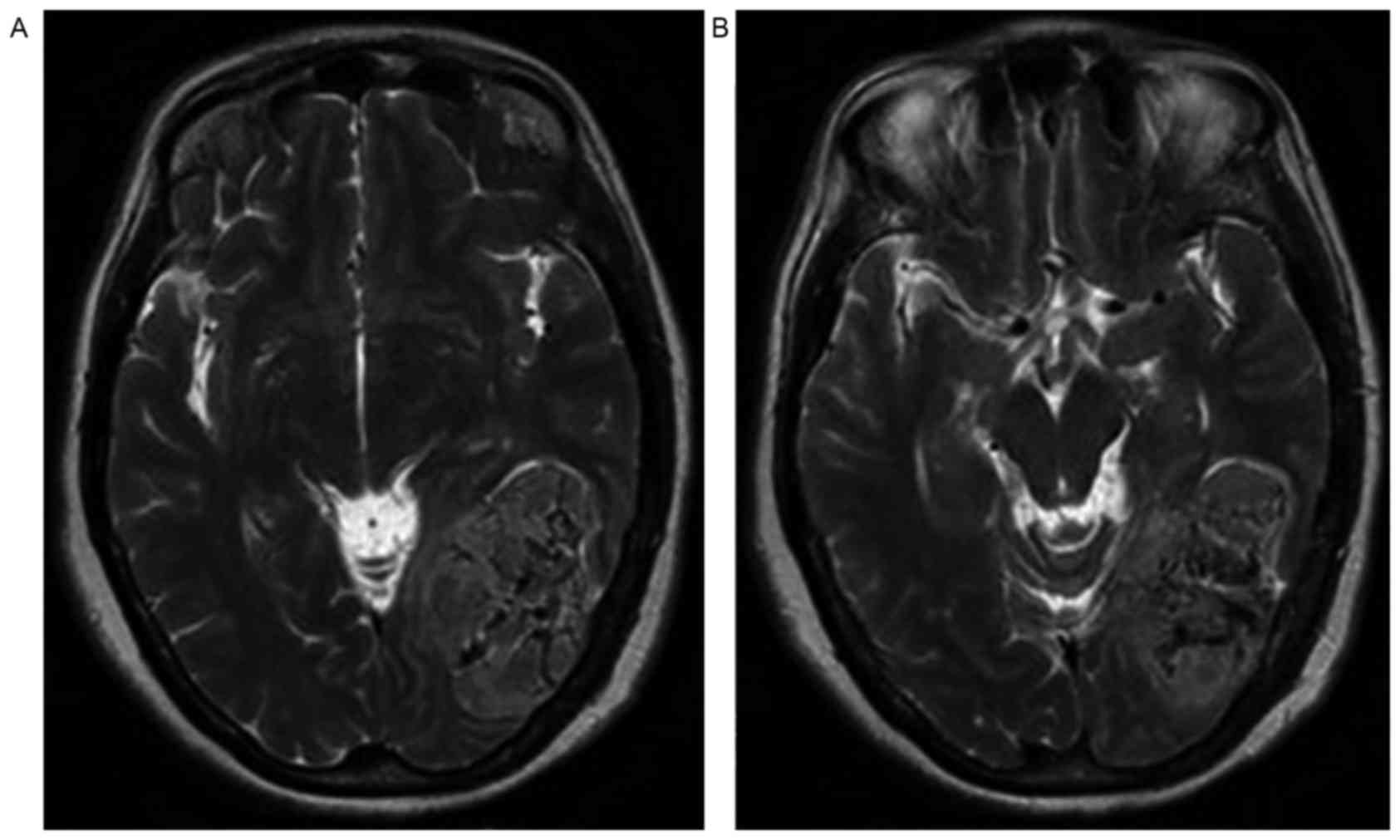|
1
|
Alawi F, Stratton D and Freedman PD:
Solitary fibrous tumor of the oral soft tissues: A
clinicopathologic and immunohistochemical study of 16 cases. Am J
Sur Pathol. 25:900–910. 2001. View Article : Google Scholar
|
|
2
|
Wagner E: Das tuberkelahnliche lymphadenom
(der cytogene oder reticulirte tuberkel). Arch Heilk (Leipzig).
11:4971870.(In German).
|
|
3
|
Klemperer P and Coleman BR: Primary
neoplasms of the pleura: A report of five cases. Am J Ind Med.
22:1–31. 1992. View Article : Google Scholar : PubMed/NCBI
|
|
4
|
de Perrot M, Fischer S, Bründler MA,
Sekine Y and Keshavjee S: Solitary fibrous tumors of the pleura.
Ann Thorac Surg. 74:285–293. 2002. View Article : Google Scholar : PubMed/NCBI
|
|
5
|
Guinee DG and Allen TC: Primary pleural
neoplasia: Entities other than diffuse malignant mesothelioma. Arch
Pathol Lab Med. 132:1149–1170. 2008.PubMed/NCBI
|
|
6
|
Zhang ZL, Gu XW, Xiao Q and Wang CM:
Clinicopathological analysis of solitary fibrous tumor in 11
patients. Cancer Res Clin. 27(107–108): 1122015.(In Chinese).
|
|
7
|
Mekni A, Kourda J, Hammouda KB, Tangour M,
Kchir N, Zitouna M and Haouet S: Solitary fibrous tumour of the
central nervous system: Pathological study of eight cases and
review of the literature. Pathology. 41:649–654. 2009. View Article : Google Scholar : PubMed/NCBI
|
|
8
|
Carneiro SS, Scheithauer BW, Nascimento
AG, Hirose T and Davis DH: Solitary fibrous tumour of the meninges:
A lesion distinct from fibrous meningioma. A clinicopathologic and
immunohistochemical study. AM J Clin Pathol. 106:217–224. 1996.
View Article : Google Scholar : PubMed/NCBI
|
|
9
|
Lococo F, Cesario A, Cardillo G, Filosso
P, Galetta D, Carbone L, Oliaro A, Spaggiari L, Cusumano G,
Margaritora S, et al: Malignant solitary fibrous tumors of the
pleura: Retrospective review of a multicenter series. J Thorac
Oncol. 7:1698–1706. 2012. View Article : Google Scholar : PubMed/NCBI
|
|
10
|
Val-Bernal JF, Mayorga M, Fernández F,
Parra A, Crespo J and García-Polavieja M: Solitary fibrous tumors
arising from the mesentery of adult patients. Report of two cases
and review of the literature. Rom J Morphol Embryol. 55:203–207.
2014.PubMed/NCBI
|
|
11
|
Bisceglia M, Dimitri L, Giannatempo G,
Carotenuto V, Bianco M, Monte V, D'Angelo V and Magro G: Solitary
fibrous tumor of the central nervous system: Report of an
additional 5 cases with comprehensive literature review. Int J Surg
Pathol. 19:476–486. 2011. View Article : Google Scholar : PubMed/NCBI
|
|
12
|
Yan J, Ahl KL, Manning KA, Mann FA and
Lewis DH: Radiology-pathology conference: 18F-FDG PET-CT imaging of
solitary fibrous tumor of the pleura. Clin Imaging. 37:598–601.
2013. View Article : Google Scholar : PubMed/NCBI
|
|
13
|
Cui J, Han LX, Cao HX, Du WQ, Zhang L,
Wang J and Chen G: MRI characteristic of intracranial solitary
fibrous tumors. Radiol Pract. 31:224–227. 2016.(In Chinese).
|
|
14
|
Liu H, Yang ZQ, Wang YT, Liu X, Chen H,
Zhang TJ and Luo KJ: CT and MRI findings of intracranial solitary
fibrous tumor. J Clin Radiol. 30:1265–1268. 2011.(In Chinese).
|
|
15
|
Chen H, Zeng XW, Wu JS, Dou YF, Wang Y,
Zhong P, Xu R, Jiang CC and Wang XQ: Solitary fibrous tumor of the
central nervous system: A clinicopathologic study of 24 cases. Acta
Neurochir (Wien). 154:237–248. 2012. View Article : Google Scholar : PubMed/NCBI
|
|
16
|
Zhanlong M, Haibin S, Xiangshan F,
Jiacheng S and Yicheng N: Variable solitary fibrous tumor
locations: CT and MR imaging features. Medicine (Baltimore).
95:e30312016. View Article : Google Scholar : PubMed/NCBI
|
|
17
|
Smith AB, Horkanyne-Szakaly I, Schroeder
JW and Rushing EJ: From the radiologic pathology archives: Mass
lesions of the dura: Beyond meningioma-radiologic-pathologic
correlation. Radiographics. 34:295–312. 2014. View Article : Google Scholar : PubMed/NCBI
|
|
18
|
Savastano S, d'Amore ES, Beghetto M, Borgo
DD, Franceschetti I and Capalbo M: A presacral solitary fibrous
tumor with extramedullary hematopoiesis: Radiologic and pathologic
findings. Rare Tumors. 5:e612013. View Article : Google Scholar : PubMed/NCBI
|
|
19
|
Bisceglia M, Galliani C, Giannatempo G,
Lauriola W, Bianco M, D'angelo V, Pizzolitto S, Vita G, Pasquinelli
G, Magro G and Dor DB: Solitary fibrous tumor of the central
nervous system: A 15-year literature survey of 220 cases (August
1996-July 2011). Adv Anat Pathol. 18:356–392. 2011. View Article : Google Scholar : PubMed/NCBI
|
|
20
|
Tihan T, Viglione M, Rosenblum MK, Olivi A
and Burger PC: Solitary fibrous tumors in the central nervous
system. A clinicopathologic review of 18 cases and comparison to
meningeal hemangiopericytomas. Arch Pathol Lab Med. 127:432–439.
2003.PubMed/NCBI
|
|
21
|
Ke DB, Liu WK, Zhang S, Yu Y, Zhang YK and
Hui XH: MRI manifestations of intracranial solitary fibrous tumor.
West China Med J. 32:46–50. 2017.(In Chinese).
|
|
22
|
Fargen KM, Opalach KJ, Wakefield D, Jacob
RP, Yachnis AT and Lister JR: The central nervous system solitary
fibrous tumour: A review of clinical, imaging and pathologic
findings among all reported cases from 1996 to 2010. Clin Neurol
Neurosurg. 113:703–710. 2011. View Article : Google Scholar : PubMed/NCBI
|
|
23
|
Zhang X, Wang H, Wang S, Miao J, Piao Z
and Dong Y: Clinicopathological analysis of solitary fibrous tumor.
Chinese-German J Clin Oncol. 11:282–284. 2012. View Article : Google Scholar
|
|
24
|
Wang C, Manucha V, Faro S, Weaver M and
Mukherjee AL: Fourth ventricular solitary fibrous tumor: A case
report and review of the literature. J Med Case Rep. 6:2052012.
View Article : Google Scholar : PubMed/NCBI
|
|
25
|
Robert T, Duc C, San Millán Ruíz D and
Morard M: Solitary fibrous tumour with intramedullary component:
Case report and review of the literature. Neurol Neurochir Pol.
48:144–149. 2014.PubMed/NCBI
|
|
26
|
Treglia G, Oragano L, Fadda G, Raffaelli
M, Lombardi CP, Castaldi P and Rufini V: A rare case of solitary
fibrous tumor of the adrenal gland detected by (18)F-FDG PET/CT.
Clin Nucl Med. 39:475–477. 2014. View Article : Google Scholar : PubMed/NCBI
|
|
27
|
Dong A, Zuo C, Wang Y and Cui Y: Enhanced
CT and FDG PET/CT in malignant solitary fibrous tumor of the lung.
Clin Nucl Med. 39:488–491. 2014. View Article : Google Scholar : PubMed/NCBI
|
|
28
|
Dai Y, Long LL and Ye W: MR imaging
features of intracranial solitary fibrous tumors. Radiol Pract.
30:127–130. 2015.(In Chinese).
|
|
29
|
Nawashiro H, Nagakawa S, Osada H, Katoh H,
Ohnuki A, Tsuzuki N, Miyazawa T, Shima K, Ogata S and Aida S:
Solitary fibrous tumor of the meninges in the posterior cranial
fossa: Magnetic resonance imaging and histological correlation-case
report. Neurol Med Chir (Tokyo). 40:432–434. 2000. View Article : Google Scholar : PubMed/NCBI
|
|
30
|
Caroli E, Salvati M, Orlando ER, Lenzi J,
Santoro A and Giangaspero F: Solitary fibrous tumors of the
meninges: Report of four cases and literature review. Neurosrug
Rev. 27:246–251. 2004.
|
|
31
|
Tihan T, Viglione M, Rosenblum MK, Olivi A
and Burger PC: Solitary fibrous tumors in the central nervous
system. A clinicopathologic review of 18 cases and comparison to
meningeal hemangiopericytomas. Arch pathol Lab Med. 127:432–439.
2003.PubMed/NCBI
|
|
32
|
Metellus P, Bouvier C, Guyotat J, Fuentes
S, Jouvet A, Vasiljevic A, Giorgi R, Dufour H, Grisoli F and
Figarella-Branger D: Solitary fibrous tumors of the central nervous
system: Clinicopathological and therapeutic considerations of 18
cases. Neurosurgery. 60:715–722. 2007. View Article : Google Scholar : PubMed/NCBI
|
|
33
|
Wang XQ, Zhou Q, Li ST, Liao CL, Zhang H
and Zhang BY: Solitary fibrous tumors of the central nervous
system: Clinical features and imaging findings in 22 patients. J
Comput Assist Tomogr. 37:658–665. 2013. View Article : Google Scholar : PubMed/NCBI
|
|
34
|
Clarençon F, Bonneville F, Rousseau A,
Galanaud D, Kujas M, Naggara O, Cornu P and Chiras J: Intracranial
solitary fibrous tumor: Imaging findings. Eur J Radiol. 82:387–394.
2011. View Article : Google Scholar
|
|
35
|
Chong S, Kim TS, Cho EY, Kim J and Kim H:
Benign localized fibrous tumour of the pleura: CT features with
histopathological correlations. Clin Radiol. 61:875–882. 2006.
View Article : Google Scholar : PubMed/NCBI
|
|
36
|
Zhang WD, Chen JY, Cao Y, Liu QY and Luo
RG: Computed tomography and magnetic resounance imaging findings of
solitary fibrous tumors in the pelvis: Correlation with
histopathological findings. Eur J Radiol. 78:65–70. 2011.
View Article : Google Scholar : PubMed/NCBI
|
|
37
|
Yang BT, Song ZL, Wang YZ, Dong JY and
Wang ZC: Solitary fibrous tumor of the sinonasal cavity: CT and MR
imaging findings. AJNR Am J Neuroradiol. 34:1248–1251. 2013.
View Article : Google Scholar : PubMed/NCBI
|
|
38
|
Glazer-Hockstein C, Syed NA, Warhol M and
Gausas RE: Malignant solitary fibrous tumor metastatic to the
orbit. Ophthal Plast Reconstr Surg. 20:471–473. 2004. View Article : Google Scholar : PubMed/NCBI
|
|
39
|
Woo KI, Suh YL and Kim YD: Solitary
fibrous tumor of the lacrimal sac. Ophthal Plast Reconstr Surg.
15:450–453. 1999. View Article : Google Scholar : PubMed/NCBI
|
|
40
|
Han YP, Zhang YT, Liu JL, Zhang XL and
Zhou JL: Comparison of imaging and pathological findings of
intracranial hemangiopericytoma and solitary fibrous tumor. Chin J
Magn Reson Imaging. 6:917–924. 2015.(In Chinese).
|
|
41
|
Sun J, Yu XR, Shi BB, Zheng J and Wu JT:
CT features of retroperitoneal solitary fibrous tumor: Report of
three cases and review of the literature. World J Surg Oncol.
12:3242014. View Article : Google Scholar : PubMed/NCBI
|

















